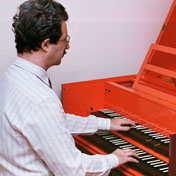Excerpts from this book:
Fingering example by François Couperin from his L'Art De toucher le Clavecin,
Paris 1717, p. 50, for a passage of his piece Les Ondes.
INTRODUCTION
Every keyboard player who has tried to play F. Couperin's Pièces following his fingering system, knows too well that the attempt is fraught with difficulties. This is because L'Art de Toucher, although a mine of information about French Baroque fingering, is far from being a comprehensive treatise about technique and interpretation. ... Hopefully, the present fully-Baroque-fingered edition will help students and even professional harpsichordists in achieving the stylish rendering F. Couperin's masterpieces deserve.
FINGERING PRINCIPLES
In the Baroque era, an amateur player surely did not have in mind the multiple finger crossings available. She/he would finger a piece not worrying if a less-than-adequate finger here and there yielded an irregular rhythm or articulation. A professional and teacher, such as François Couperin, thought differently, and recommended fingerings that facilitated—as much as possible—the desired control of performance down to the smallest details. For most pieces, the fingering in this edition is the author's hypothetical historical reconstruction of the fingering the composer would have approved of.
DETAILS ON THE PERFORMANCE OF EACH PIECE
La Milordine, Gigue
TITLE. According to Beaussant the title might allude to king James II of England [who sought refuge in France after his defeat in the Battle of the Boyne in 1690], but this is highly speculative and even unlikely: the title is likely to refer to some other Englishman.
PERFORMANCE. Marked "Gracieusement et legérement". Legérement means fast (in other words, every dotted crotchet is one beat, not three), while gracieusement prevents from playing it too mechanically. There are many short and slurred ornaments on the weak beat in this piece, and one should refrain from the modern temptation of playing them before the beat ... This piece, however, provides us a good example of the few cases in which a pre-beat performance of appoggiaturas is required: on bars 2 and 4 the appoggiatura is slurred to the following note in order to produce a detachment from the previous shake (mordent in bar 2, trill in bar 4), yet the appoggiatura is to be played before the shake on three counts: ...
FINGERING. Couperin provided some fingerings for this piece in L'Art de Toucher: as always for these original fingerings, here they are shown in green colour in the score. The [finger] substitutions are yet another clue that prevents a performance from being really fast.
ERRORS. ... On bar 14 we have added the missing trill over f#. ...

Fingering for La Manon
(as employed in the author's YouTube video )
Les Silvains
TITLE AND STYLE. This is the first piece in Couperin's Livres that (a) is not a dance, (b) follows the—by then quite outmoded—lute style and (c) employs only the bass and tenor range.
RANGE. Indeed, the range used is GG-g', i.e. three octaves only. Moreover, most of the piece lays in barely more than two octaves: D-e', and therefore with suitable transposition is playable on a small octave virginal. On the other hand, the bass sequence in bars 59-60 and 63-64 is somewhat odd.
This is because ... throughout his Premier Livre, with the only exception of La Bandoline, the composer scrupulously avoided the BB flat in order to fit the pieces within the common “broken short octave from GG ” range. However, by 1713 the new range down to FF was fast becoming common in France, and it is thus fully justifiable to reconstruct the “logical”—and in the author’s opinion much better sounding—bass sequence DD-BBb-CC-DD, possibly omitting the mordent on BBb, now laying too low for such an ornament. This alternative being an “error correction” of sorts, we have shown it in the score in blue colour, using the same colour for the related alternative fingering.
REGISTRATION. Baroque directions for changing stops between sections of a French Rondeau are very rare: only two cases are known to the author, and we can conclude that this was not a common registration practice. However, in this particular piece, the author finds it proper to go to the upper manual for the 2nd part in minor mode, perhaps returning to the lower manual for the repeat of the final Arpegemens.
PERFORMANCE. For this piece the composer provided yet another crucial direction on articulation, specifying “tres liés”, i.e. very legato, even over-legato. One should refrain, however, from playing these passages as arpeggio chords, keeping all the notes down (as suggested in Rameau’s Table): whenever Couperin wanted this effect he wrote it down in full detail.
FINGERING. This piece is a good example where the marked slurs are unplayable without the chains of substitutions the composer proudly described a few years later in his L’Art de Toucher, where on p. 47 he also provided fingerings for two passages in the SECOND PARTIE. The first passage occurs more than once, and we have applied Couperin’s fingerings to all these passages ...
ERRORS. Three bars after the beginning of the Arpegemens, we have added to the f# a missing—and significant—stem.

Fingering for La Bourbonnoise
Sarabande L'Unique
STYLE. “Unique” perhaps because of the changes in metre and tempo, although there are a few other Sarabandes by the composer with these types of changes.
REGISTRATION. The combination of lower 8' + 4' (used above in the Allemande L’Ausoniéne) is normally considered better-sounding than the more nasal upper 8' + 4': this latter combination is nowadays rarely used, also because often it implies two stop changes plus coupling. However, using this registration here serves to provide attractive variety. The manuals have already been coupled for the previous piece, so we just disengage the lower 8' and engage the 4'.
PERFORMANCE. On bars 19, in the original edition the l.h. f# and g are on the l.h. stave, because placing them on the r.h. one would have been cumbersome. However, this is not a prescription for a left hand execution of these notes, which are much more comfortable to play with the right thumb as shown in our score. ...




